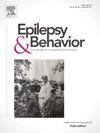探索抑郁症状与癫痫发作结果之间的相互作用:一项对迷走神经刺激治疗的耐药癫痫患者的单中心研究
IF 2.3
3区 医学
Q2 BEHAVIORAL SCIENCES
引用次数: 0
摘要
背景:dvagus神经刺激(VNS)是一种安全有效的治疗方案,适用于耐药癫痫(DRE)和难治性抑郁症患者。VNS可导致DRE患者抑郁症状的改善,独立于其对癫痫发作控制的影响。然而,在接受VNS治疗的患者中,抑郁症状和癫痫发作结果之间的关系仍然不确定。目的本研究旨在评估抑郁症状的存在或不存在是否影响经VNS治疗的DRE患者的癫痫发作结局。方法在坦佩雷大学医院神经内科门诊接受VNS治疗的51例连续成人DRE患者进行随访研究。所有患者在VNS基线(植入前)前接受精神病学评估。在基线和整个随访期间反复使用贝克抑郁量表- 1a (BDI)评估抑郁症状的严重程度。根据患者在基线时和VNS植入后随访期间的BDI评分,我们将患者分为两组:i)有抑郁症状(PWE + DS)的患者,BDI评分为>;在基线或随访期间至少一次,ii)无抑郁症状(PWE - DS),所有BDI评分≤12的患者。癫痫发作的主要结局指标是>;50%的癫痫发作减少(应答者),他们的主要癫痫发作类型。结果基线时,29.4%的患者诊断出精神合并症,平均基线BDI评分为7.0(中位数为5.0,范围0-41)。PWE + DS占研究人群的41.2%,PWE - DS占58.8%。中位随访时间为39个月(6-102个月)。主要发作类型的总应答率为52.1%,PWE + DS组应答率明显高于PWE - DS组(73.7% vs. 37.9%, p = 0.027)。在11例以双侧强直-阵挛性发作为主的患者中,81.8%的患者有反应,72.8%的患者实现了这种发作类型的发作自由。结论有抑郁症状的DRE患者对VNS治疗的效果优于无抑郁症状的DRE患者。这一意想不到的发现可以用癫痫发作和抑郁症状的共同神经生物学背景来解释,这可能受到VNS治疗的影响。以FBTCS为主要发作类型的患者获得了最有利的结果。在更大的有抑郁症状的DRE患者队列中进行进一步的研究是有必要验证我们的结果的。本文章由计算机程序翻译,如有差异,请以英文原文为准。
Exploring the interplay between depressive symptoms and seizure outcomes: A single-centre study of drug-resistant epilepsy patients treated with vagus nerve stimulation
Background
Vagus nerve stimulation (VNS) is a safe and effective treatment option for patients with drug-resistant epilepsy (DRE) and for those with treatment-resistant depression. VNS can lead to the amelioration of depressive symptoms in patients with DRE, independent of its impact on seizure control. However, the relationship between depressive symptoms and seizure outcomes in patients receiving VNS therapy remains uncertain.
Objective
This study aimed to assess whether the presence or absence of depressive symptoms influences seizure outcomes in patients with DRE treated with VNS.
Methods
This follow-up study included 51 consecutive adult DRE patients treated with VNS at the Neurology Outpatient Clinic at Tampere University Hospital. All patients underwent a psychiatric evaluation before VNS at baseline (pre-implantation). The severity of depressive symptoms was assessed using the Beck Depression Inventory-1A (BDI) at baseline and repeatedly throughout the follow-up period. We categorized patients into two groups based on the presence or absence of depressive symptoms, as determined by their BDI scores at baseline and during the follow-up after VNS implantation: i) patients with depressive symptoms (PWE + DS), with a BDI score > 12 at least once either at baseline or during the follow-up, and ii) patients without depressive symptoms (PWE - DS), with all BDI scores ≤ 12. The primary seizure outcome measure was the number of patients with > 50 % seizure reduction (responders) for their predominant seizure type.
Results
At baseline, psychiatric comorbidities were diagnosed in 29.4 % of patients, and the average baseline BDI score was 7.0 (median 5.0, range 0–41). PWE + DS comprised 41.2 % and PWE - DS 58.8 % of the study population. The median duration of follow-up was 39 months (range 6–102 months). The overall responder rate was 52.1 % for the predominant seizure type, with significantly more responders in the PWE + DS group than in the PWE - DS group (73.7 % vs. 37.9 %, p = 0.027). Among the 11 patients whose predominant seizure type was focal to bilateral tonic-clonic seizures (FBTCS), 81.8 % were responders, and 72.8 % achieved seizure freedom for this seizure type.
Conclusion
Our study indicates that DRE patients with depressive symptoms respond better to VNS therapy for their predominant seizure type than those without depressive symptoms. This unexpected finding may be explained by the shared neurobiological background of seizures and depressive symptoms, potentially influenced by VNS treatment. Patients with FBTCS as their predominant seizure type achieved the most favourable outcomes. Further investigations in a larger cohort of DRE patients with depressive symptoms are warranted to validate our results.
求助全文
通过发布文献求助,成功后即可免费获取论文全文。
去求助
来源期刊

Epilepsy & Behavior
医学-行为科学
CiteScore
5.40
自引率
15.40%
发文量
385
审稿时长
43 days
期刊介绍:
Epilepsy & Behavior is the fastest-growing international journal uniquely devoted to the rapid dissemination of the most current information available on the behavioral aspects of seizures and epilepsy.
Epilepsy & Behavior presents original peer-reviewed articles based on laboratory and clinical research. Topics are drawn from a variety of fields, including clinical neurology, neurosurgery, neuropsychiatry, neuropsychology, neurophysiology, neuropharmacology, and neuroimaging.
From September 2012 Epilepsy & Behavior stopped accepting Case Reports for publication in the journal. From this date authors who submit to Epilepsy & Behavior will be offered a transfer or asked to resubmit their Case Reports to its new sister journal, Epilepsy & Behavior Case Reports.
 求助内容:
求助内容: 应助结果提醒方式:
应助结果提醒方式:


